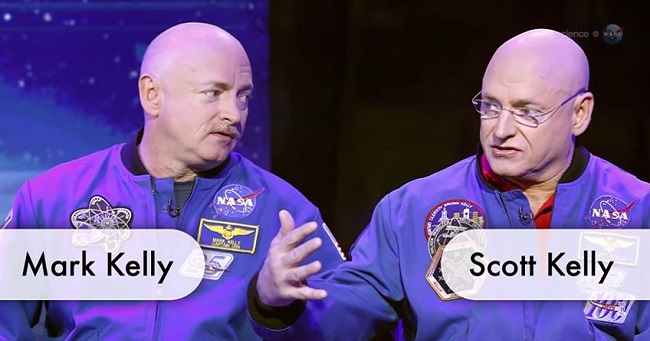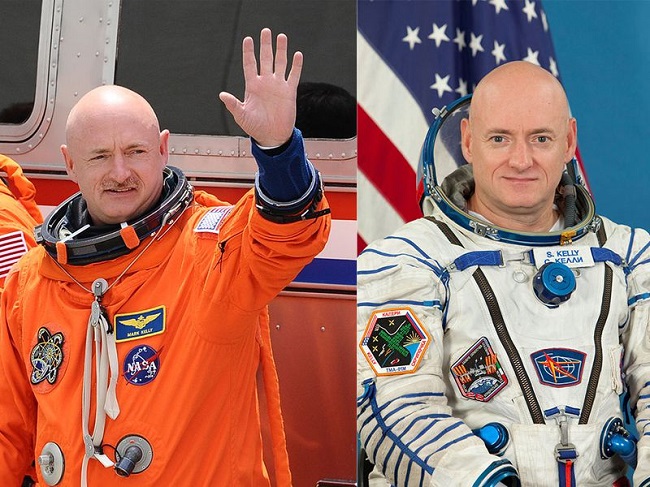


For an Astronaut, space travel can be a life-changing experience. It can also alter a person’s mental perception of the universe but besides the mental and life changes, there is much more than an astronaut undergoes when traveling in space. Even as your organs are simply floating around in your body due to lack of gravity, the change isn’t an external one. A NASA study done in 2015-16 as part of its human research programme ahead of a planned mission to Mars has now revealed the results that show space can even alter your DNA. The NASA twins study may have been done in 2015-16 but after a grueling analysis and investigation by 12 universities including NASA biomedical laboratories and the National Space Biomedical Research Institute took time and now finally the first batch of results are out and it is mind-blowing for scientists around the world.
If you are still wondering what the Twin Study is all about, well NASA wanted to see how Space actually affects us internally. The twins study involved two twin astronauts, Scott and Mark Kelly. Scott Kelly spent almost a year in space aboard the ISS International Space Station with Russian Astronaut Mikhail Kornienko while Mark stayed on earth. The first preliminary results of the study revealed something astonishing, that Mark had grown two inches taller and there were marked changes in his DNA.
The NASA twin study has yielded its first results that show space travel increases DNA methylation which is a process that turns genes on and off. It proves that DNA changes when you’re in space where one of the most visible of changes was Scott’s height that had grown by 2 inches. The study also observed that telomeres (regions at the end of DNA chromosomes in white blood cells whose purpose is for protection’) in Scotts DNA had gown longer. Telomeres usually reduce with age.
Said Doctor Chris Mason of Weill Cornell medicine and principal investigator of the study” “Some of the most exciting things that we’ve seen from looking at gene expression in space is that we really see an explosion, like fireworks taking off, as soon as the human body gets into space, with this study, we’ve seen thousands and thousands of genes change how they are turned on and turned off. This happens as soon as an astronaut gets into space, and some of the activity persists temporarily upon return to Earth.”

Image Source: www.thumbs-prod.si-cdn.com
According to Mason, the NASA Twin study is one of the most extensive in human biology which will help scientists understand the molecular risks in space travel and create ways to protect genetic changes. The research studies four main elements of human biology. Physiology and how various organs such as the heart and brain were affected by microgravity, perception and reasoning changes in the brain which incidentally forms the core of healthy behavior, the human microbiome and how gut bacteria was affected by space flight. The final and fourth element was the observations on gene changes between Scott and Mark.
The unique study as a first of its kind for NASA would have not been possible had it not been for the cooperation of Scott and Mark. While Scott remained in Space for about 11 months along with his Russian partner, Kornienko, Mark remained on earth. The study is part of NASA human research program to try and make space flight as safe as possible.
Image Source: www.eurekalert.org
The early results of the study yielded interesting elements of genetic change. While the aspect of telomere growth fascinated scientists, it was also suggested that the growth could have been due to the rigorous exercise routines that astronauts have to undergo as well a reduction in calories during a mission. The surprising factor was that telomeres reduce with aging. However, it was also noted that the DNA changes in Scott returned back to normal after he returned to earth.
Where the Biochemical profile was concerned, researchers found a decline in bone formation during the second half of the space mission. There was also an increase in inflammatory elements immediately after landing which research attributes to increased levels of cortisol, the stress hormone which remained normal throughout the mission. Scotts reduced bone formation could have been due to exercise and countermeasures during the mission.
Image Source: www.internapcdn.net
There were several marked differences between viral, bacterial and fungal micrbiomes observed in gut bacteria between both twins at all times. The dominant change observed was a shift in the ratio between two of the most dominant groups of bacteria in Scott's gut microbiome. However, the changes reversed to normal after he returned back to earth. In general, there were several other minor changes and differences between the gut microbiome of both twins during the mission which could have been the result of a different diet and environment.
The entire study is yet to be published as it is still going on and hopefully will yield even more startling results. The Human Research Program is an initiative by NASA that dedicates itself to discovering new methods and technology to produce safer means of space travel. The main goal of the Human Research Program and its genetic studies is to create a safe environment for astronauts to ultimately travel to Mars. NASA’s twin space study is coinciding with the most powerful spacecraft built for a Mars mission scheduled for 2030.
Image Source: www.jpl.nasa.gov
NASA has an ongoing ambitious project of sending astronauts to mars whose foundation has been built upon the several robotic space missions to the red planet. It also centers on the SLS or space launch system that will ultimately be the most powerful rocket system ever built to send astronauts deep into the solar system. A spacecraft for this purpose is NASA's Orion which will also be the most powerful exploration vehicle that will protect astronauts in their journey to deep space, provide emergency abort facilities and sustain crews during space travel as well as providing a safe environment for re-entry back to earth. The main thrust capacity of the rocket system or thrust vector control is being constructed by a team led by engineer Leonardo Barreda at NASA’s Marshall Spaceflight Center.
The Orion will be launched with the help of the SLS or space launch system. Ground testing of the Orion began on Oct 30th, 2017 as intensive preparations are underway for an expected launch date sometime in 2013 when humans will finally set foot on Mars. The NASA twins study will also help the mission create safer and protective environments for astronauts in space.
Image Source: www.jpl.nasa.gov